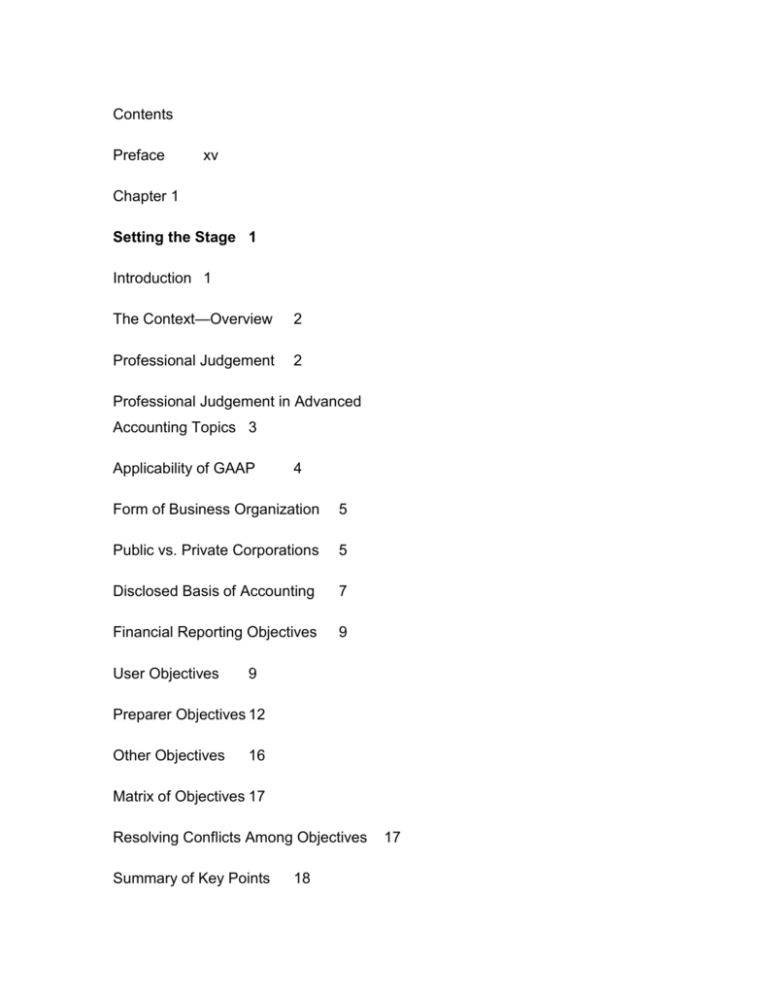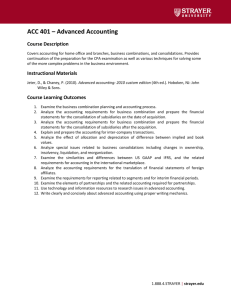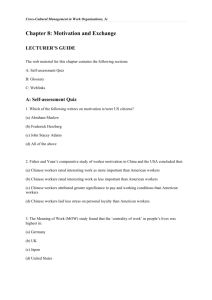or view the full Table of Contents in Microsoft Word format
advertisement

Contents Preface xv Chapter 1 Setting the Stage 1 Introduction 1 The Context—Overview 2 Professional Judgement 2 Professional Judgement in Advanced Accounting Topics 3 Applicability of GAAP 4 Form of Business Organization 5 Public vs. Private Corporations 5 Disclosed Basis of Accounting 7 Financial Reporting Objectives 9 User Objectives 9 Preparer Objectives 12 Other Objectives 16 Matrix of Objectives 17 Resolving Conflicts Among Objectives Summary of Key Points 18 17 Weblinks 19 Review Questions 20 Cases 22 Chapter 2 Intercorporate Investments: An Introduction 32 Introduction 32 Branch Accounting 33 Definition of Intercorporate Investments 33 Portfolio lnvestments—A Quick Review 34 Strategic Intercorporate Investments Controlled Subsidiaries 35 35 Significantly Influenced Affiliates 40 Joint Ventures 41 Reporting Investments in Affiliates and Subsidiaries Cost-Basis Reporting 42 Equity-Basis Reporting 42 Consolidation 43 Reporting versus Recording Methods Example of Accounting for Strategic Investments 45 44 42 Consolidation When the Cost Method Is Used 46 The Equity Method 52 Unconsolidated Statements 57 Limitations of Consolidated Statements 57 Summary of Accounting for Intercorporate Investments Summary of Key Points Weblinks 60 61 Self-Study Problem 62 Review Questions 63 Cases 65 Problems 69 Chapter 3 Business Combinations 77 Introduction 77 Definition of a Business Combination 77 Accounting for Business Combinations— General Approach 78 Measuring the Cost 78 Determining Fair Values Allocating the Cost 80 79 59 Illustration of a Direct Purchase of Net Assets 81 Purchase of Shares 83 Reasons for Purchasing Shares 83 Share Exchanges 85 Illustration of a Share Exchange 87 Alternative Approaches to Reporting Business Combinations Overview 88 88 Pooling of Interests 89 Purchase Method 91 New-Entity Method 91 Other Approaches 92 Purchase vs. Pooling 92 Current Canadian Practice 93 Corporate Restructurings—Non-Arm’s-Length Pooling 94 International Practices for Business Combinations 94 Consolidation Procedures 96 Direct Method 96 Worksheet Method 97 Negative Goodwill 99 Disclosure 101 Recording Fair Values: Push-Down Accounting 102 Summary of Key Points Weblinks 104 105 Self-Study Problem 106 Appendix: Income Tax Allocation 107 Introduction 107 Temporary Differences in Business Combinations 108 Unrecognized Tax Loss Carryforwards 110 Equity-Basis Reporting 111 Review Questions 111 Cases 114 Problems 120 Chapter 4 Wholly-Owned Subsidiaries: Reporting Subsequent to Acquisition 128 Introduction 128 Consolidation One Year After Acquisition Basic Information 129 128 Amortization of Fair Value Increments Unrealized Profits 132 Direct Method 133 Worksheet Approach 131 137 Equity-Basis Reporting of Non-Consolidated Subsidiaries Comparison of Consolidation vs. Equity Reporting 142 Discontinued Operations and Extraordinary Items 144 Consolidation in Second Subsequent Year Basic Information 145 Direct Method 145 Worksheet Approach 145 150 Completed Consolidated Financial Statements 153 Alternative Presentation of Goodwill Amortization 153 Note Disclosure 155 Consolidating Parent-Founded Subsidiaries Indirect Holdings 157 Summary of Key Points Weblinks 158 157 156 140 Self-Study Problems 159 Appendix: Income Tax Allocation Subsequent to Acquisition 162 Introduction and Review 162 Post-Acquisition Tax Accounting for Fair Value Increments Unrealized Profit Summary 162 164 165 Review Questions 165 Cases 166 Problems 170 Chapter 5 Consolidation of Non-Wholly-Owned Subsidiaries 183 Introduction 183 Conceptual Alternatives 183 Illustration of the Alternative Approaches 185 Summary of Consolidation Approaches 190 Consolidation at Date of Acquisition Direct Method 190 190 Worksheet Approach 192 Consolidation One Year after Acquisition 193 Basic Information 193 Direct Method 194 Worksheet Approach 200 Consolidation in Second Subsequent Year Direct Method 204 Worksheet Approach The Next Steps 207 210 Summary of Key Points Weblinks 202 210 210 Self-Study Problems 211 Review Questions 216 Cases 217 Problems 223 Chapter 6 Subsequent-Year Consolidations: General Approach 238 Introduction 238 Intercompany Sale of Long-Term Assets 239 General Concept 239 Downstream Sales of Amortizable Assets 240 Upstream Sales of Amortizable Assets 242 Direct Amortization 243 Subsequent Sale of Capital Assets Acquired Intercompany Subsequent-Year Consolidations—General Approach 245 Basic Conceptual Approach Basic Information 247 A Caveat for Students Direct Approach 246 250 250 Worksheet Approach 256 Equity-Basis Reporting 261 Consolidation with Equity-Basis Recording Extraordinary Items and Discontinued Operations 265 Summary of Key Points Weblinks 265 266 Self-Study Problems 267 Appendix: Intercompany Bond Holdings 268 Intercompany Bond Transactions 268 Indirect Acquisitions of Bonds 269 Non-Wholly-Owned Subsidiaries 271 263 245 Subsidiary Purchase of Parent’s Bonds 273 Summary 274 Self-Study Problem (Appendix) 275 Review Questions 275 Cases 276 Problems 284 Chapter 7 Strategic Investments: Additional Aspects of Share Capital 317 Introduction 317 Preferred and Restricted Shares of Investee Corporations Introduction 318 Effect of Preferred Shares on Investor’s Ownership Interest 318 Investment in Preferred Shares Restricted Shares 320 Changes in Ownership Interest Step Purchases 320 322 322 Increases in Equity-Basis Investments 327 Acquisition of Significant Influence 327 Decreases in Ownership Interest 328 318 Sale of Part of an Investment 328 Issuance of Shares by Subsidiary Summary of Key Points Weblinks 330 332 333 Self-Study Problems 333 Review Questions 335 Cases 336 Problems 342 Chapter 8 Segmented and Interim Reporting 358 Introduction 358 Segmented Reporting 358 Introduction 358 Applicability 359 Operating Segments 360 Enterprise-Wide Disclosures 363 Examples of Segmented Reporting Interim Reporting 366 Introduction 366 General Principles of Application 368 365 The Periodicity Problem 370 Discrete Approach 371 Integral Approach 371 Application in Practice 372 Illustrative Interim Statement Summary of Key Points Weblinks 374 380 381 Review Questions 382 Cases 383 Problems 384 Chapter 9 Foreign Currency Transactions 389 Introduction 389 Foreign Currency Transactions 389 Causes of Exchange Rate Changes 390 Transactions and Current Balances 391 Long-Term Balances 396 Accounting for Hedges 400 Nature of Hedging 400 Hedge Accounting Recommendations— Old versus Proposed 402 Hedging a Monetary Position Hedging a Commitment Implicit Hedges 412 Imperfect Hedges 414 Summary of Key Points Weblinks 402 410 415 416 Self-Study Problems 417 Review Questions 418 Cases 420 Problems 422 Chapter 10 Reporting Foreign Operations 429 Introduction 429 Translation Methods Temporal Method 429 430 Monetary/Nonmonetary Method 433 Relationship of Temporal Method to Transaction Accounting 433 Current-Rate Method 435 Current/Noncurrent Method 436 Summary of Translation Methods 437 Accounting Exposure vs. Economic Exposure 438 Alternatives for Reporting Translation Gains and Losses 440 Immediate Recognition Disaggregation Deferral 440 442 442 The Two Solitudes: Integrated vs. Self-Sustaining Operations 443 Integrated Foreign Operations 444 Self-Sustaining Foreign Operations 445 Operations in Hyper-Inflationary Economies Application of Section 1650 Recommendations 446 Integrated Operations 446 Self-Sustaining Operations 447 Extending the Example 447 Comparison of Accounting Implications 454 Summary of Key Points 455 446 Weblinks 456 Self-Study Problems 456 Review Questions 458 Cases 460 Problems 473 Chapter 11 Financial Reporting for Non-Profit Organizations 491 Introduction 491 Overview of Non-Business Organizations 491 Characteristics of Non-Profit Organizations 492 No Owners 493 A Different “Bottom Line” 493 Relationship Between Revenue and Costs Objectives of Financial Reporting 495 Primary Reporting Issues 496 Expense versus Expenditure Reporting 496 Capital Assets 498 Segregation of Resources 499 Donated Goods and Services Accounting for Pledges 501 500 494 Accounting for a Collection 501 Defining the Reporting Entity 502 Consolidated or Combined Statements 503 GAAP for Non-Profit Organizations Types of Financial Statements 504 505 Reporting Options 505 Traditional Method 505 CICA Handbook Methods 506 Illustration of Reporting Methods 512 Deferral Method 512 Restricted Fund Method 513 The Chore of Users: Unravelling GAAP 514 Budgetary Control and Encumbrance Accounting 515 Budgetary Control Accounts 516 The Encumbrance System 516 A Final Example 517 Summary of Key Points 521 Appendix: Fund Accounting Introduction 524 524 Purpose of Fund Accounting Types of Funds 525 Account Groups 527 525 Fund Accounting and the Segregation of Funds 528 Interfund Transfers 528 Summary of Key Points Weblinks 529 530 Review Questions 530 Cases 532 Chapter 12 Public Sector Financial Reporting 545 Introduction 545 Contrast Between NPOs and Governments Public Sector Reporting Standards The Compliance Issue 548 Objectives of Governmental Reporting Qualitative Characteristics 550 Types of Financial Statements Major Reporting Issues 546 553 551 549 545 Cash vs. Accrual 553 Expense vs. Expenditure Basis Capital Assets 554 555 Consolidation and the Reporting Entity 556 Restricted Assets and Revenues 557 Liability Measurement 558 Other lssues 558 Summary of Key Points Weblinks 559 560 Review Questions 560 Cases 561 Solutions to Self-Study Problems 562 Index 589






